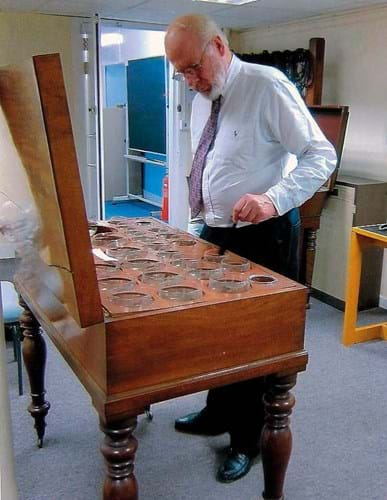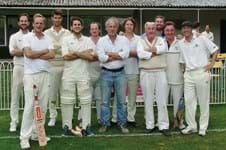He had contacts all over the world including the US, the Netherlands, Germany and the Czech Republic. His trips to all these countries with members of the Glass Circle became the stuff of legend. Fun-filled and, above all, embracing new discoveries about glass-making and glass history, these forays were important for extending knowledge of many collections and workers in glass, and glass history in general.
A native of Burton-on-Trent, John attended Repton School and took a degree in chemistry from Bristol University. After a period in the chemical industry, in 1974 John inherited a general antiques business, Hennings, which had been established in 1922 by his stepmother’s father at 61 George Street in the West End.
He closed down that business in the early 1980s and opened his own shop, Regency House Antiques, in Walton-on- Thames, Surrey. Its bow window and extensive stock is well remembered by dealers who visited him to make purchases.
After this business closed John then joined Aspreys on Bond Street for several years. Here he worked with Derek Davis, son of the well-known glass dealer Cecil Davis. While running the glass department John held exhibitions on green table glass and British and Continental table glass.
Move to Mallett
When he moved to Mallett in 1990, many of John’s customers came with him as Aspreys ceased to trade in glass. Following the trend for deeper research into objects on the market, John held a series of exhibitions accompanied by catalogues: A Collection of Fine Glass from the Restoration to the Regency (1990), Engraved Glass Masterpieces from Holland, Crystal for Royalty and Rajahs (1991), The Age of Enlightenment: A History of Glass Chandelier Manufacture and Design (1994), James Tassie 1735- 1799, Modeller in Glass, A Classical Approach (1995), and Danny Lane, Breaking Traditions (1999).
With Martine Newby and Henry Fox he organised From Palace to Parlour, A Celebration of 19th Century British Glass held at the Wallace Collection, London, in 2003 to coincide with the conference of the Association pour l’Histoire du Verre (AHV) held in London that year. He also contributed the two final chapters to the revised edition of Five Thousand Years of Glass (British Museum Press, 2012): ‘Europe and America 1800-1940’ and ‘The decline of the craftsman, the rise of the artist, 1940-2012’, distilling the knowledge he had built up over decades.
John lectured widely, perhaps most notably on glass furniture and glass in country houses. He was maybe unique in the English-speaking world for his knowledge both of the history of chandeliers and of the technical challenges involved in their making and installation. On at least one occasion he sold magnificent chandeliers to demanding international clients and hung them himself in their homes as part of his work for Mallett.
A member of the Glass Circle for more than 50 years, John was its chairman from 2003-17, overseeing the recent merger with the Glass Association to form the Glass Society before he stood down.
His last year was devoted to work for the British Glass Foundation, of which he became a trustee, contributing much to the project to open a new museum of glass at the White House Cone, Stourbridge, in place of the internationally renowned Broadfield House Glass Museum, closed by Dudley Council in 2015. John was also a Freeman of the Worshipful Company of Glass Sellers, an honorary member of the Guild of Glass Engravers and for several years a committee member of the Friends of the Victoria and Albert Museum, for which he raised considerable sums.
In private life John provided much hospitality at his unusual house in Suffolk: a former water tower with astonishing views. He was devoted to his six grandchildren by his first wife and to his two children. In 2005 he married Aileen Dawson, curator at the British Museum, who shared his love of travel, ski-ing, gardening and art in all its many forms.
From family













